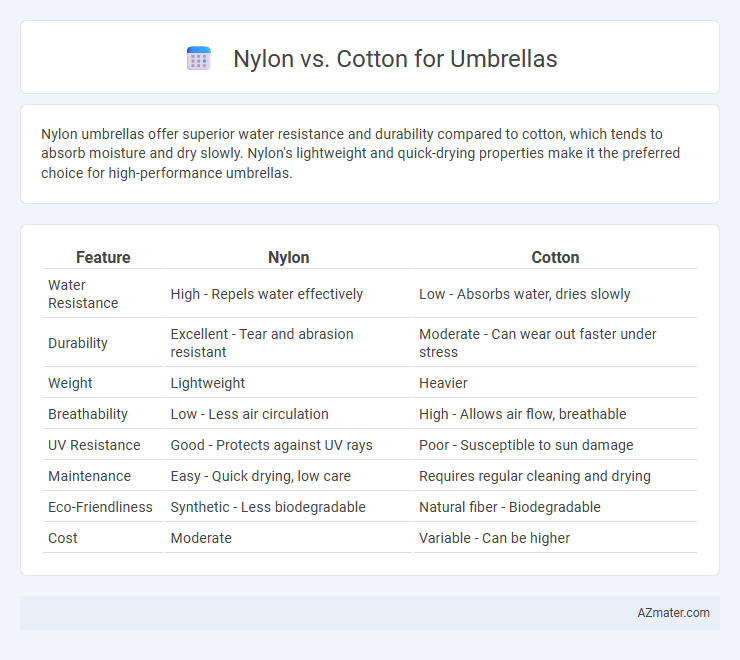Nylon umbrellas offer superior water resistance and durability compared to cotton, which tends to absorb moisture and dry slowly. Nylon's lightweight and quick-drying properties make it the preferred choice for high-performance umbrellas.
Table of Comparison
| Feature | Nylon | Cotton |
|---|---|---|
| Water Resistance | High - Repels water effectively | Low - Absorbs water, dries slowly |
| Durability | Excellent - Tear and abrasion resistant | Moderate - Can wear out faster under stress |
| Weight | Lightweight | Heavier |
| Breathability | Low - Less air circulation | High - Allows air flow, breathable |
| UV Resistance | Good - Protects against UV rays | Poor - Susceptible to sun damage |
| Maintenance | Easy - Quick drying, low care | Requires regular cleaning and drying |
| Eco-Friendliness | Synthetic - Less biodegradable | Natural fiber - Biodegradable |
| Cost | Moderate | Variable - Can be higher |
Overview: Nylon vs Cotton Umbrella Fabrics
Nylon fabric is lightweight, water-resistant, and quick-drying, making it ideal for umbrellas exposed to heavy rain and frequent use. Cotton fabric, while breathable and offering a classic appearance, tends to absorb water and dries slower, which can lead to increased weight and potential mildew over time. The durability and moisture-wicking properties of nylon typically provide superior performance compared to traditional cotton in umbrella construction.
Key Fabric Properties: Durability and Strength
Nylon offers superior durability and tensile strength compared to cotton, making it highly resistant to tearing and wear under extreme weather conditions. Cotton, while breathable and aesthetically pleasing, tends to absorb moisture, which can compromise its strength and lead to faster degradation over time. Choosing nylon for umbrella fabric enhances longevity and structural integrity, especially in heavy rain and wind scenarios.
Water Resistance Comparison
Nylon umbrellas offer superior water resistance compared to cotton due to their synthetic fibers that repel water and dry quickly. Cotton fabric tends to absorb moisture, making it less effective in heavy rain and slower to dry, which can lead to a heavier, soggy umbrella. The hydrophobic nature of nylon ensures better durability and protection during wet weather conditions.
UV Protection Capabilities
Nylon umbrellas provide superior UV protection with a higher UPF (Ultraviolet Protection Factor) rating compared to cotton, effectively blocking up to 99% of harmful UV rays. Cotton umbrellas absorb moisture and may degrade faster under prolonged sun exposure, reducing their effectiveness against UV radiation. For enhanced sun protection, nylon umbrellas with UV-resistant coatings offer durable and reliable shielding from ultraviolet rays.
Weight and Portability Differences
Nylon umbrellas are significantly lighter than cotton ones, making them more portable and easy to carry during travel or daily commutes. The synthetic fibers in nylon reduce overall umbrella weight, often by up to 50%, enhancing convenience without sacrificing durability. Cotton umbrellas tend to be heavier due to the natural fabric, which results in increased bulk and less efficient folding, impacting their ease of transport.
Aesthetic Appeal and Texture
Nylon umbrellas exhibit a sleek, glossy finish that enhances their modern aesthetic appeal, while cotton offers a matte, natural look preferred for classic or rustic designs. The smooth, water-resistant texture of nylon ensures durability and easy drying, contrasting with cotton's softer, more breathable fabric that may absorb moisture and require longer drying times. Cotton provides a tactile warmth and richness appreciated in artisanal umbrellas, whereas nylon prioritizes lightweight practicality and vibrant color retention.
Maintenance and Cleaning
Nylon umbrellas require minimal maintenance due to their water-resistant properties, allowing dirt and stains to be easily wiped away with a damp cloth. Cotton umbrellas may absorb moisture and dirt more readily, necessitating thorough drying to prevent mold and more frequent cleaning with mild soap and water. Proper care of cotton fabric ensures durability, while nylon's quick-drying nature reduces the risk of mildew buildup.
Eco-Friendliness and Sustainability
Nylon umbrellas, while durable and water-resistant, are less eco-friendly due to their petroleum-based synthetic fibers and longer biodegradation time, contributing to microplastic pollution. Cotton umbrellas offer better sustainability with a natural, biodegradable fabric, especially when sourced organically, but require more water and pesticides in conventional farming. Balancing durability and environmental impact, organic cotton umbrellas represent a more sustainable choice compared to traditional nylon alternatives.
Cost and Price Considerations
Nylon umbrellas typically cost less due to lower material and manufacturing expenses, making them a budget-friendly option for consumers. Cotton umbrellas offer a premium feel with natural fibers but come at a higher price point due to the cost of sourcing and treating the fabric. When prioritizing cost-effectiveness, nylon provides durability and affordability, while cotton balances cost with a classic aesthetic and breathability.
Best Fit: Choosing the Right Material for Your Umbrella
Nylon offers superior water resistance and durability, making it ideal for umbrellas used in heavy rain and windy conditions, while cotton provides a more breathable and natural feel but absorbs water quickly, which can lead to longer drying times. When choosing the best fit for your umbrella, consider the frequency of use and weather conditions; nylon is best for frequent exposure to wet weather, whereas cotton suits lighter, occasional use in mild climates. The blend of polyester with nylon often enhances strength and quick-drying properties, making it a practical compromise for performance and comfort.

Infographic: Nylon vs Cotton for Umbrella
 azmater.com
azmater.com